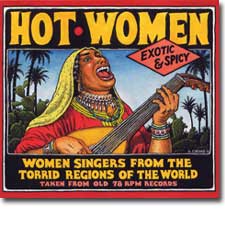Hot Women
- title
Hot Women
- label
Kein & Aber Records
- format
- various artists CD
 All it takes is to listen. R. Crumb knows that, and in his ever curious search, it's in the "hunt, the thrill of discovery" of a music untainted by commercial entities which best exemplifies self-expression in his, a collector's, "adventure into the unknown, a mysterious, vanished world, an alternate reality." Hot Women: Women Singers From the Torrid Regions is culled from 78 RPM records all recorded prior to the mid-1930s that R. Crumb himself has collected over the years. This hunt has been turned into a digital trip around the globe, with 24 songs of just such a mysterious and lost beauty. Also included are R. Crumb's personal and well researched notes, from what he could find (who are these women? he asks) on these obscure lost sounds from a long gone age.
All it takes is to listen. R. Crumb knows that, and in his ever curious search, it's in the "hunt, the thrill of discovery" of a music untainted by commercial entities which best exemplifies self-expression in his, a collector's, "adventure into the unknown, a mysterious, vanished world, an alternate reality." Hot Women: Women Singers From the Torrid Regions is culled from 78 RPM records all recorded prior to the mid-1930s that R. Crumb himself has collected over the years. This hunt has been turned into a digital trip around the globe, with 24 songs of just such a mysterious and lost beauty. Also included are R. Crumb's personal and well researched notes, from what he could find (who are these women? he asks) on these obscure lost sounds from a long gone age.
My favorite selections included music from Mexico, Chile, Cuba, Spain, Middle Congo, and Hawaii. Both track 2 - Lidya Mendoza Y Familia singing Mexico En Una Laguna (from Mexico, mid 1930s) and track 7 - Las Cuatro Huasas singing La Papa Araucana (from Chile, early 1930s) both have playful sounds with a chorus of female singers. Since I'm a sucker for family or sister styled vocals, I found these to be amongst by personal favorites.
Track 4 - Grupo De La Alegria (from Cuba, 1928) also have that playful female sister call and response vocal style on El Tambor de La Alegria. This song also sounds remarkably like the song Iko Iko - which is an added bonus.
Leona Gabriel (French Caribbean, from 1932) has a much more individual style on Liva, track 5 , and energetic, but not overly course sounding tune. In fact, I can hear the later sounds of Calypso in this song, which is a real delight. Track 8 - La Nina de los Peines is a handclapping and exuberant delight on Sevillanas No. 2, as she is accompanied by Nino Ricardo on guitar. This was recorded in Spain in 1927.
We travel all the way to Middle Congo for the most curious and out there piece of music recorded in 1933 - track 18 has Mabourdana and Badolo singing one of the most odd duets i'm sure you are going to encounter on their song Chant D'Invitation A La Dance. Whether you will be inclined to join either of these two bewitching voices remains to be seen. My last favorite song - Lei E - sung by Emma Bush with Johnny Noble and his Hawaiian Music - was recorded in Hawaii, and has some great Hawaiian guitar picking and some even more fascinating vocalizing by Emma (with backup vocals by the able voiced Johnny Noble and his Hawaiian Music).
There's quite a bit more music on this disc which is worthy of excavating and enjoying. Personally, I could've done without the Greek/Turkish/Algerian music, which seems to have a more open ended style of song. But the music I did find myself enjoying has an exuberance and joyfulness one is hard pressed to find in nowadays commercialized brand of genre-ized music. R. Crumb has done a fine job in restoring this music to an enjoyable and listenable state, as well as preserving for us a lost chapter in 20th Century music.